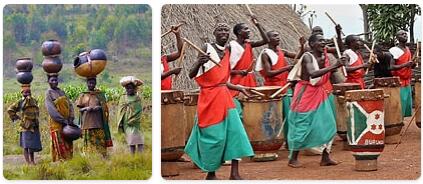
Yearbook 2004
Burundi. At a donor conference in January, the outside world pledged US $ 1.32 billion for the reconstruction of Burundi and the restoration of state finances. The World Bank gave $ 33 million to help militiamen return to civilian life.
The total population in Burundi is 11,890,795 people in 2020. The African peacekeeping force sent to Burundi in 2003 was converted from 1 June into a UN force, mandated to have a maximum of 5,650 soldiers and 120 civilian police. However, battles continued occasionally between the army and the last remaining militia, the National Liberation Forces (FNL).
The violence culminated in August with a raid on a Tutsi refugee camp from Congo-Kinshasa. The FNL is said to have carried out the attack, in which about 160 people were killed, but according to witnesses, militia forces from Congo-Kinshasa and Rwanda also participated in the assault, which led to increased tension throughout the region.
Following the mediation of a number of African heads of state, in August, an agreement on continued division of power was signed, giving Hutus and Tutsis equal numbers of seats in the Senate and Hutu 60% of seats in the government and the National Assembly. However, a number of Tutsi parties, including the dominant UPRONA, were opposed to the agreement because they believed that the Tutsis – which constitute about 14% of the population – were forced into excessive concessions. Parliament nevertheless ratified the new constitution pending a referendum, but the general elections that were held during the autumn were postponed, preliminary to April 2005.
In early December, the demobilization of both army and militia soldiers began. Of a total of about 80,000 men under arms, in the long term there will be an ethnically balanced army of 30,000 men and 20,000 police officers. The cuts will reduce the defense budget by almost two-thirds by 2007.

History. – Independence proclaimed (June 30, 1962), the political life of the kingdom of Burundi was disturbed by the constant conflict between the Ba-Hutu majority and the aristocratic Ba-Tutsi minority. Seven governments followed one another between 1962 and 1966, almost always in dissent with the National Assembly where the Ba-Hutus predominated. The opening, from the beginning of 1964, towards the People’s Republic of China – which the Burundi had fomented unrest in Zaire – was abruptly interrupted in February 1965. Following an insurrection attempt, which led to the killing of many Ba-Hutu parliamentarians, King (Mwami) Mwambutsa IV fled to Switzerland. The situation evolved further in 1966: the son of the Mwami usurped the throne under the name of Ntare V, but a few months later he was dismissed by the 26-year-old prime minister M. Micombero who assumed power alongside a National Revolutionary Committee (in 1971 a Supreme Council of the Revolution was established). New serious crisis in 1972: after an attempted reactionary coup, connected with the return to the country of the deposed Ntare V, who was killed, Micombero instilled a tougher military regime, oriented to the left (Chinese influence had indeed reaffirmed itself from a few years, even if the Burundi had strengthened relations with Belgium and in general with Western Europe). The tribal conflict is rekindled: the Ba-Hutus rise up, aided by neighboring countries, but the Ba-Tutsis react with equal harshness; there are 100 to 200,000 dead and 100,000 refugees in Tanzania, Zaire and Rwanda, a potential element of friction with those states. The contrast between the two great ethnic groups of Burundi in addition there is that between the BaTutsi groups in the north and those in the south, which mostly hold government and public offices. The tough military government of Micombero (re-elected head of state in 1974) does not seem capable of achieving better national integration nor of overcoming economic difficulties (the country registers one of thelowest per capita in the world).